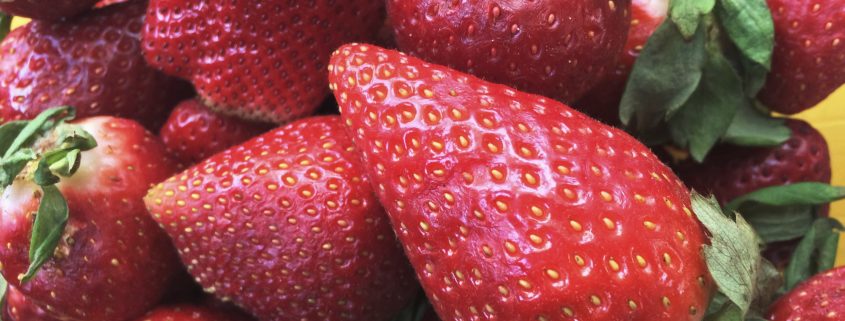May Monthly Morsels
 Sweet, Sweet Strawberries
Sweet, Sweet Strawberries
By Charna Sheinfeld, Nutrition Intern
The tantalizing aroma, bright red color, and alluring flavor of strawberries is allowing me to believe that spring has truly sprung. How appropriate it is that May is the month we celebrate these robust berries? This is the time of year that strawberries are at their peak season, meaning you can pick up a tasty carton without paying an arm and a leg for it. Luckily for us, these juicy berries are packed with health benefits, making them a perfect snack to enjoy this season.
Truth be told, strawberries are actually considered a “false fruit” because they are made up of dozens of tiny individual fruits coming together as one. These individual fruits are called achenes and are all surrounding the tiny seeds you see. Due to all the seeds in strawberries, they are very high in fiber. They are also a great source of vitamin C, folate, potassium, and calories! Strawberries have an exceptional combination of phtyonutrients including anthocyanins, flavanols, terpenoids, and phenolic acids. These are all forms of antioxidants that provide anti-inflammatory properties.
Strawberries are also the third highest food source of polyphenols, behind olives and coffee. Polyphenols are compounds that have been found to play a major role in regulating your blood sugar response. This makes strawberries a wonderful fruit choice for those with type 2 diabetes or anyone who is trying to avoid sharp spikes in blood sugar.
When selecting strawberries, buy ones that are plump, firm, shiny, and deep red in color. They should be free of mold and still be attached to their green leaves. If you smell the carton, you should be able to smell that distinctive aroma of fresh strawberries.
Food scientists have also emphasized the importance of how to store strawberries in order to get the most of their flavor and nutrients. It has been found that after 2 days strawberries begin to lose major amounts of vitamin C and polyphenol antioxidants. In addition, optimal humidity for strawberry storage is 90-95%. Most refrigerators have an 80-90% humidity, so it may be helpful to store the berries in the storage bins when possible because they have higher humidity.
Here are two recipes using strawberries for you to enjoy. Don’t forget that you also can enjoy this amazing berry on its own, added to plain yogurt, in shakes, smoothies, or in a salad.
French Toast Sandwiches Stuffed with Strawberries and Greek Yogurt
Share in the comments below how you like to eat strawberries.


Leave a Reply
Want to join the discussion?Feel free to contribute!